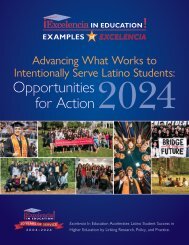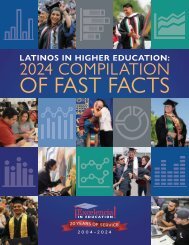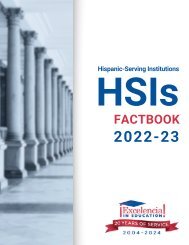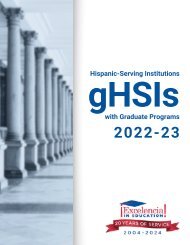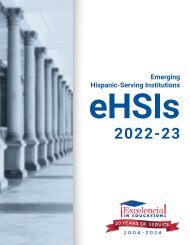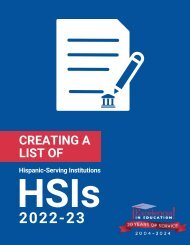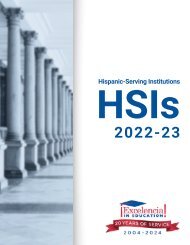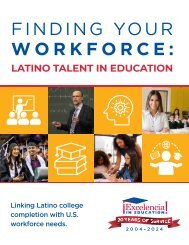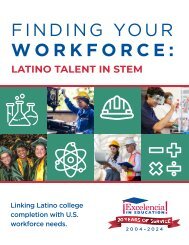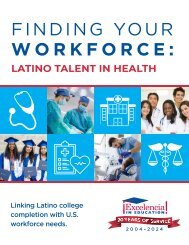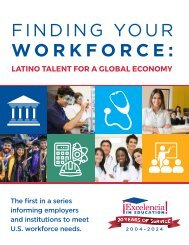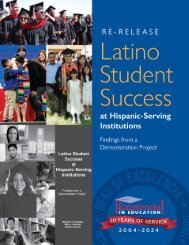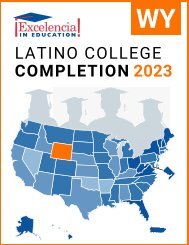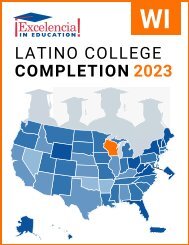Latino College Completion 2023: Oklahoma
Create successful ePaper yourself
Turn your PDF publications into a flip-book with our unique Google optimized e-Paper software.
OK
LATINO COLLEGE COMPLETION:<br />
OKLAHOMA – <strong>2023</strong><br />
For the U.S. to regain the top ranking in the world for college degree<br />
attainment, <strong>Latino</strong>s will need to earn 6.2 million degrees by 2030. 1<br />
FAST FACTS<br />
STATE RANKING:<br />
<strong>Oklahoma</strong> had the 24th largest<br />
<strong>Latino</strong> population in the U.S.<br />
K-12 POPULATION:<br />
In <strong>Oklahoma</strong>, 18% of the K-12<br />
population was <strong>Latino</strong>. 2<br />
POPULATION:<br />
In <strong>Oklahoma</strong>, 12% of the population<br />
was <strong>Latino</strong>. 2<br />
MEDIAN AGE:<br />
The median age<br />
of Hispanics<br />
in <strong>Oklahoma</strong> was<br />
24, compared<br />
to 42 for White<br />
non-Hispanics. 2<br />
24<br />
Hispanics<br />
42<br />
White<br />
non-Hispanics<br />
ENROLLMENT:<br />
In <strong>Oklahoma</strong>, 14% of Hispanics<br />
(ages 18 to 34) were enrolled in higher<br />
education, compared to 19% of<br />
White non-Hispanics. 2<br />
DEGREE ATTAINMENT:<br />
In <strong>Oklahoma</strong>, 20% of Hispanic<br />
adults (25 and older) had earned an<br />
associate degree or higher, compared to<br />
39% of White non-Hispanic adults. 2<br />
Hispanic Adults = 2.0 of 10<br />
To reach the degree attainment goal by 2030, the U.S. can: close<br />
the degree completion gap by accelerating <strong>Latino</strong> completion while<br />
increasing for all students and scale up programs and initiatives that<br />
work for <strong>Latino</strong>, and all, students. The following demographics,<br />
institutional data, and practices inform <strong>Latino</strong> degree attainment.<br />
ENROLLING: Top 5 Institutions (Hispanic Undergraduates) in <strong>Oklahoma</strong>, 2021-22<br />
Institution<br />
Sector<br />
Grand<br />
Total<br />
NOTE: We use the terms <strong>Latino</strong> and Hispanic interchangeably in this factsheet.<br />
Hispanic<br />
Total<br />
Source: Excelencia in Education analysis using U.S. Department of Education, National Center for<br />
Education Statistics (NCES), Integrated Postsecondary Education Data System (IPEDS), 2021 Fall<br />
Enrollment, Graduation Rates Survey and Institutional Characteristics Survey.<br />
%<br />
Hispanic<br />
1 University of <strong>Oklahoma</strong>-Norman Campus Public, 4-year 20,800 2,607 13%<br />
2 <strong>Oklahoma</strong> State University-Main Campus Public, 4-year 19,841 1,757 9%<br />
3 <strong>Oklahoma</strong> City Community <strong>College</strong> Public, 2-year 9,759 1,746 18%<br />
4 University of Central <strong>Oklahoma</strong> Public, 4-year 11,420 1,625 14%<br />
5 Tulsa Community <strong>College</strong> Public, 2-year 11,810 1,459 12%<br />
ASSOCIATE DEGREES: Top 5 Institutions Awarding to Hispanics in <strong>Oklahoma</strong>, 2020-21<br />
Institution<br />
Sector<br />
Grand<br />
Total<br />
Hispanic<br />
Total<br />
%<br />
Hispanic<br />
1 <strong>Oklahoma</strong> City Community <strong>College</strong> Public, 2-year 1,770 266 15%<br />
2 Tulsa Community <strong>College</strong> Public, 2-year 2,401 241 10%<br />
3 <strong>Oklahoma</strong> State University-<strong>Oklahoma</strong> City Public, 4-year 806 106 13%<br />
4 Rose State <strong>College</strong> Public, 2-year 772 68 9%<br />
5 Northern <strong>Oklahoma</strong> <strong>College</strong> Public, 2-year 565 66 12%<br />
BACHELOR DEGREES: Top 5 Institutions Awarding to Hispanics in <strong>Oklahoma</strong>, 2020-21<br />
Institution<br />
Sector<br />
Grand<br />
Total<br />
Hispanic<br />
Total<br />
%<br />
Hispanic<br />
1 University of <strong>Oklahoma</strong>-Norman Campus Public, 4-year 4,665 479 10%<br />
2 <strong>Oklahoma</strong> State University-Main Campus Public, 4-year 4,519 333 7%<br />
3 University of Central <strong>Oklahoma</strong> Public, 4-year 2,442 271 11%<br />
4 Northeastern State University Public, 4-year 1,465 90 6%<br />
Private not-forprofit,<br />
4-year<br />
5 Mid-America Christian University<br />
287 76 26%<br />
White Adults = 3.9 of 10<br />
1 Projections to 2030: Excelencia in Education. (2020). Ensuring America’s Future: Benchmarking <strong>Latino</strong><br />
<strong>College</strong> <strong>Completion</strong> to 2030. Excelencia in Education. Washington, D.C.<br />
2 U.S. Census Bureau, 2021 American Community Survey 1-Year Estimates
<strong>Oklahoma</strong> Gap in Degree <strong>Completion</strong><br />
Closing the degree completion gap can be tracked<br />
by the 4 measures shown below. Alone, none<br />
of these measures capture the entire “story” of<br />
degree completion. However, in combination,<br />
they provide a useful picture of the gap in degree<br />
attainment between Hispanic and White non-<br />
Hispanic cohorts in a single year.<br />
Graduation Rate — Total percentage of students<br />
who graduated within 150% of normal time for<br />
first-time, full-time freshmen. This incorporates<br />
students that graduated in 3 years at two-year<br />
institutions, or in 6 years at four-year institutions.<br />
Transferred to Another Institution —<br />
Percentage of students that transferred to another<br />
institution and did not complete a degree.<br />
Still Enrolled — Percentage of students that are<br />
still enrolled at the point of 150% normal time to<br />
completion.<br />
No Longer Enrolled — Percentage of students<br />
that are no longer enrolled at the point of 150%<br />
normal time to completion.<br />
At two-year institutions, Hispanics’<br />
graduation rate was the same as<br />
that of their White non-Hispanic<br />
peers in <strong>Oklahoma</strong>.<br />
TWO-YEAR INSTITUTIONS<br />
47%<br />
12%<br />
34%<br />
WHITE<br />
0%<br />
48%<br />
7% 8%<br />
10%<br />
34%<br />
HISPANIC<br />
DEGREE OUTCOMES<br />
■ No Longer Enrolled<br />
■ Still Enrolled<br />
■ Transferred to<br />
Another Institution<br />
■ Graduation Rate<br />
*Percentages may not add up to 100% due to rounding.<br />
At four-year institutions, Hispanics’<br />
graduation rate was 7%-points<br />
lower than that of their White<br />
non-Hispanic peers in <strong>Oklahoma</strong>.<br />
FOUR-YEAR INSTITUTIONS<br />
2%<br />
28%<br />
58%<br />
WHITE<br />
-7%<br />
32%<br />
51%<br />
HISPANIC<br />
NOTE: Outcomes shown are for students at two-year institutions who started in Fall 2018, and<br />
for students at four-year institutions who started in Fall 2015.<br />
Source: Excelencia in Education analysis using the U.S. Department of Education, National<br />
Center for Education Statistics (NCES), Integrated Postsecondary Education Data System, 2021<br />
Graduation Rates Survey and the Institutional Characteristics Survey.<br />
13%<br />
3%<br />
14%<br />
Examples of What Works for <strong>Latino</strong> Students<br />
There are institutions showing success in enrolling, retaining, and graduating <strong>Latino</strong> students. The following are examples of<br />
programs across the country with evidence of effectiveness in serving <strong>Latino</strong> students nominated for Examples of Excelencia.<br />
The Early <strong>College</strong> High School Program was developed in 2006 when<br />
South Texas <strong>College</strong> partnered with Progreso Independent School District<br />
(a small rural district with a high school student population of approx. 300<br />
students). South Texas <strong>College</strong> designed the Early <strong>College</strong> High School<br />
program to provide an environment that is conducive to learning where<br />
students become more engaged, inquisitive, and are able to advocate<br />
for themselves. Their objective is to provide students with a seamless<br />
transition to a four-year institution or a technical degree in a high skill, high<br />
demand career field. The Early <strong>College</strong> High Schools program is designed<br />
under a small school model‚ where 100 to 125 ninth grade students start<br />
the program every year. Teaching and learning in all courses are based on<br />
common instructional frameworks that emphasize collaborative learning,<br />
intensive writing, critical thinking, open discussion, scaffolding, and mastery<br />
learning. Early <strong>College</strong> High Schools specifically target populations of<br />
students that are potential first-generation college attendees from low<br />
socio-economic backgrounds. They provide a nurturing atmosphere for<br />
students that require extra support systems and accelerated programs<br />
to help them succeed. Ideally, the 9th and 10th-grade years of the Early<br />
<strong>College</strong> High School student experience are designed to prepare students<br />
for college-level coursework. In the 11th and 12th grade years, students<br />
are eligible to enroll in and complete dual enrollment/dual credit courses.<br />
There are approximately 6,000 students in the pipeline who<br />
successfully enrolled in college coursework. Of students enrolled<br />
in South Texas <strong>College</strong>’s 30 Early <strong>College</strong> High Schools, 98% are<br />
Hispanic, and 100% of them qualify for free or reduced lunch. There<br />
are an estimated 950 additional students that will graduate “core<br />
complete” or with a minimum of 12 college credit hours. Early<br />
<strong>College</strong> High Schools program has steadily increased the number<br />
of seniors graduating with associate degrees from 28 in 2011 to an<br />
estimated 530 in 2015. In total, 1,431 students have graduated with an<br />
associate degree during the last 5 years.<br />
For more information on institutional programs improving <strong>Latino</strong> student success in higher education, access Excelencia in<br />
Education’s Growing What Works database at http://www.edexcelencia.org/growing-what-works<br />
ENSURING AMERICA’S FUTURE BY INCREASING LATINO COLLEGE COMPLETION • WWW.EDEXCELENCIA.ORG




